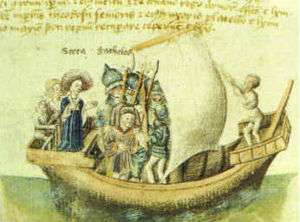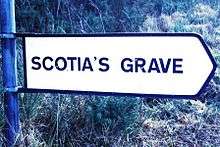Scota


Scota and Scotia are the names given to the mythological daughters of two different Egyptian pharaohs in Irish mythology, Scottish mythology and pseudohistory.[1] Though legends vary, all agree that a Scota was the ancestor of the Gaels, who traced their ancestry to Irish invaders, called Scotti, who settled in Argyll and Caledonia, regions which later came to be known as Scotland after their founder.
Early sources
Edward J. Cowan traced the first mention of Scota in literature to the 12th century.[2] Scota appears in the Irish chronicle Book of Leinster (containing a redaction of the Lebor Gabála Érenn).[3] However, a text found in the 11th-century Historia Brittonum contains an earlier reference to Scota.[4] 12th-century sources state that Scota was the daughter of an Egyptian pharaoh, a contemporary of Moses, who married Geytholos (Goídel Glas), the founder of the Scots and Gaels after being exiled from Egypt.[5] The earliest Scottish sources claim Geytholos was a king of Greece, Neolus or Heolaus, while the Lebor Gabála Érenn describes him as a Scythian. Other manuscripts of the Lebor Gabála Érenn contain a variant legend where Mil Espaine appears as Scota's husband, and connects him to ancient Iberia.[6]
A variant myth in the Lebor Gabála Érenn states that there was another Scota. She was the daughter of an Egyptian pharaoh named Cingris, a name found only in Irish legend. She married Niul, son of Fenius Farsaid. Niul was a Babylonian who traveled to Scythia after the collapse of the Tower of Babel. He was a scholar of languages and was invited by the Pharaoh to Egypt to take Scota's hand in marriage. Scota and Nuil had a son, Goídel Glas, the eponymous ancestor of the Gaels, who created the Gaelic language by combining the best features of the 72 languages then in existence.
Scota and the Stone of Scone
Baldred Bisset is credited with being the first to connect the Stone of Scone with the Scota foundation legends in his 1301 work Processus, putting forward an argument that Scotland, not Ireland, was where the original Scota homeland lay.[7]
Bisset wanted to legitimize a Scottish (as opposed to English) accession to the throne when Alexander III of Scotland died in 1286. At his coronation in 1249, Alexander himself heard his royal genealogy recited generations back to Scota. Bisset attempted to legitimize a Scottish accession by highlighting Scota's importance as the transporter of the Stone of Scone from Egypt during the exodus of Moses to Scotland. In 1296, the Stone was captured by Edward I of England and taken to Westminster Abbey. In 1323, Robert the Bruce used Bisset's legend connecting Scota to the Stone in an attempt to return it to Scone Abbey in Scotland.[8]
The 15th-century English chronicler John Hardyng later attempted to debunk Bisset's claims.[9]
Later sources
Andrew of Wyntoun's Orygynale Cronykil of Scotland and John of Fordun's Chronica Gentis Scotorum (1385) are sources of the Scota legends, alongside Thomas Grey's Scalacronica (1362). Hector Boece's 16th-century Historia Gentis Scotorum ("History of the Scottish People") also mentions the Scota foundation myth.
Walter Bower's 15th-century Scotichronicon included the first illustrations of the legends.
Grave of Scota

The grave of Scota (or Scotia's Grave) allegedly lies in a valley south of Tralee Town, Co. Kerry, Ireland. The area is known as Glenn Scoithin, "Vale of the Little Flower", but is more popularly referred to as Foley's Glen (Foley's Glen). A trail from the road leads along a stream to a clearing where a circle of large stones marks the grave site, as indicated by a County Council signpost.
Sources
- Lebor Gabála Érenn
- Geoffrey Keating, Forus Feasa ar Éirinn
- Seumas MacManus, The Story of the Irish Race (February 1970 The Devin-Adair Company New York)
- Seumas MacManus, The Story of the Irish Race (1990 edition printed by Wings Books)
- Michael O'Clery, Annals of the Kingdom of Ireland (1616–1636 Donegal)
- Benedict Fitzpatrick's (1901–1963) "Ireland and the Foundations of Europe"
See also
References
- ↑ Lennon, Joseph (2008). Irish Orientalism: A Literary and Intellectual History. Syracuse University Press. p. 5-57. ISBN 9780815631644. Retrieved 14 June 2018.
- ↑ Myth and Identity in Early Medieval Scotland, EJ Cowan, Scottish Historical Review lxiii, No. 176 (Oct. 1984) pp.111–35.
- ↑ "Lebor Gabála Érenn".
- ↑ The Irish identity of the kingdom of the Scots in the 12th and 13th centuries, Dauvit Broun, Boydell & Brewer Ltd, 1999, p. 78.
- ↑ W. Matthews, "The Egyptians in Scotland: the Political History of a Myth", Viator 1 (1970), pp.289–306.
- ↑ A dictionary of Celtic mythology, James MacKillop, Oxford University Press, 2004, p. 330.
- ↑ The Irish identity of the kingdom of the Scots in the 12th and 13th centuries, Dauvit Broun, Boydell & Brewer Ltd, 1999, p. 120.
- ↑ Reading the medieval in early modern England, Gordon McMullan, David Matthews, Cambridge University Press, 2007, p. 109.
- ↑ Glastonbury Abbey and the Arthurian tradition, James P. Carley, Boydell & Brewer, 2001, p. 275 ff.